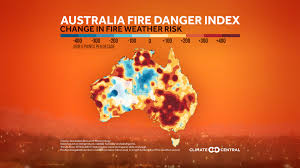From the Australian Security Leaders Climate Group, 2022
As ex-Service members and experienced security practitioners who have witnessed up-close the devastation of war and crisis, we consider that climate change now represents the greatest threat to the future and security of Australians.
The first duty of government is the safety and protection of the people, but Australia has failed when it comes to climate change threats. Australia currently has no credible climate policy, leaving our nation unprepared for increasingly harsh impacts.
We call upon all those offering themselves as political leaders in this election year to make climate change a primary focus and commit to mobilising the resources necessary to address this clear and present danger.
Our Earth is already too hot and climate change is already dangerous. Fossil fuel emissions must be reduced to zero at emergency speed. The goal of net zero emissions by 2050 is wholly inadequate; decarbonisation must be reached as close to 2030 as possible. Accelerating renewables to secure energy resilience in a conflicted world is critical for Australia.
Climate change imperils the health, well-being and livelihoods of Australia’s people. Hotter and more extreme weather, floods, bushfires, cyclones and heatwaves, together with coastal inundation, are threatening water, transport, food and other critical infrastructure systems, disrupting supply chains and undermining our resilience as a nation.
The recent east coast floods and the Black Summer bushfires compelled major peacetime mobilisations of the Australian Defence Force, including Reserves, which is now increasingly being used to undertake climate-related humanitarian and disaster relief.
The Great Barrier Reef is at risk of collapse; likewise irrigated agriculture in the longer term in the Murray-Darling Basin system, which remains under severe stress.
Across our region, climate change is an existential threat to nations and communities, especially those vulnerable to sea-level rise. Globally, water and food crises exacerbated by climate change, along with population pressures, have resulted in escalating cycles of civil unrest and conflict. Inevitably, vulnerable people migrate from affected areas in increasing numbers.
Addressing this challenge requires global co-operation rather than conflict. While our allies are taking action, climate-security risks are not being properly assessed in Australia; we are ill-prepared, and failing in our responsibilities as a global citizen and strategic defence ally.
Climate must be made an immediate security priority, at the top of the national agenda, with a commitment for mobilisation and emergency action from all sides of politics.
Yours Sincerely, Australian Security Leaders Climate Group
#######+++++++#######+++++++#######
WATCH “CLIMATE RISK IS THE BIGGEST RISK BUSINESS FACES” ~ IAN DUNLOP’S CLIMATE & SECURITY INSIGHTS
Brief Video Presentation by the Distinguished Ian Dunlop
Ian Dunlop is an Australian engineer, writer, and energy expert with a particular interest in the interaction of corporate governance, corporate responsibility and climate change. Previously, Ian worked in oil, gas and coal exploration and production, and scenario and long-term energy planning. He was a senior executive of Royal Dutch Shell for many years and CEO of the Australian Institute of Company Directors (1997-2001). He chaired the Australian Coal Association (1987-88) and the Australian Greenhouse Office Experts Group on Emissions Trading, which developed the first emissions trading system design for Australia (1998-2001).


{ 1 comment… read it below or add one }
What’s causing Sydney’s monster flood crisis – let’s stop it from happening again
From an Article by Dale Dominey-Howes, The Conversation, July 3, 2022
Again, thousands of residents in Western Sydney face a life-threatening flood disaster. At the time of writing, evacuation orders spanned southwest and northwest Sydney and residents of the Hawkesbury-Nepean Valley were being warned the crisis was escalating.
It’s just over a year since the region’s long-suffering residents lived through one of the largest flood events in recent history. And of course, earlier this year floods devastated the Northern NSW town of Lismore.
Right now, attention is rightly focused on helping those immediately affected by the disaster. But as the floodwaters subside, we must urgently act to avert a repeat of this crisis.
Obviously, nature is a major culprit here. But there’s plenty humans can do to plan for major flooding and make sure we’re not sitting in the path of disaster.
Looking ahead to the near term future, farther out and long term future …
Unfortunately, the wet conditions we’re now seeing may persist for some time. Recent climate modelling suggests Australia may face a third consecutive La Nina this spring and summer.
This extra rain will fall on already soaked landscapes, further increasing the likelihood of flooding. And the ramifications will extend far beyond affected communities.
Disruptions will be felt in agriculture, supply chains, transport routes and broader state and national economies.
In the longer term, of course, climate change is projected to bring far worse extreme rain events than in the past. The current flood crisis will recede, but the need to plan for future flooding disasters has never been more pressing.
https://theconversation.com/whats-causing-sydneys-monster-flood-crisis-and-3-ways-to-stop-it-from-happening-again-186285